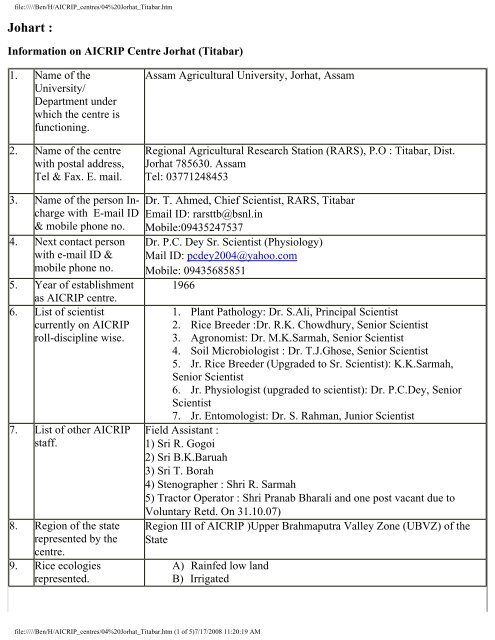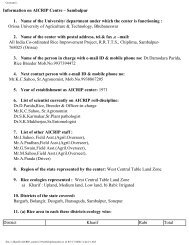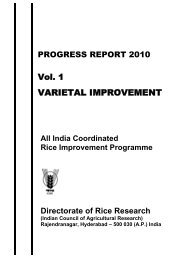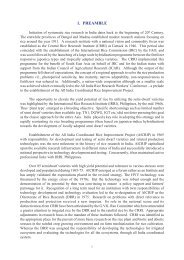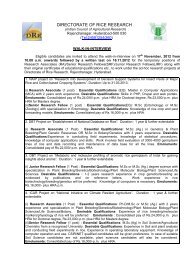You also want an ePaper? Increase the reach of your titles
YUMPU automatically turns print PDFs into web optimized ePapers that Google loves.
file://///Ben/H/AICRIP_centres/04%20Jorhat_Titabar.htm<br />
<strong>Johart</strong> :<br />
Information on AICRIP Centre Jorhat (Titabar)<br />
1. Name of the<br />
University/<br />
Department under<br />
which the centre is<br />
functioning.<br />
2. Name of the centre<br />
with postal address,<br />
Tel & Fax. E. mail.<br />
3. Name of the person Incharge<br />
with E-mail ID<br />
& mobile phone no.<br />
4. Next contact person<br />
with e-mail ID &<br />
mobile phone no.<br />
5. Year of establishment<br />
as AICRIP centre.<br />
6. List of scientist<br />
currently on AICRIP<br />
roll-discipline wise.<br />
7. List of other AICRIP<br />
staff.<br />
8. Region of the state<br />
represented by the<br />
centre.<br />
9. Rice ecologies<br />
represented.<br />
Assam Agricultural University, Jorhat, Assam<br />
Regional Agricultural Research Station (RARS), P.O : Titabar, Dist.<br />
Jorhat 785630. Assam<br />
Tel: 03771248453<br />
Dr. T. Ahmed, Chief Scientist, RARS, Titabar<br />
Email ID: rarsttb@bsnl.in<br />
Mobile:09435247537<br />
Dr. P.C. Dey Sr. Scientist (Physiology)<br />
Mail ID: pcdey2004@yahoo.com<br />
Mobile: 09435685851<br />
1966<br />
1. Plant Pathology: Dr. S.Ali, Principal Scientist<br />
2. Rice Breeder :Dr. R.K. Chowdhury, Senior Scientist<br />
3. Agronomist: Dr. M.K.Sarmah, Senior Scientist<br />
4. Soil Microbiologist : Dr. T.J.Ghose, Senior Scientist<br />
5. Jr. Rice Breeder (Upgraded to Sr. Scientist): K.K.Sarmah,<br />
Senior Scientist<br />
6. Jr. Physiologist (upgraded to scientist): Dr. P.C.Dey, Senior<br />
Scientist<br />
7. Jr. Entomologist: Dr. S. Rahman, Junior Scientist<br />
Field Assistant :<br />
1) Sri R. Gogoi<br />
2) Sri B.K.Baruah<br />
3) Sri T. Borah<br />
4) Stenographer : Shri R. Sarmah<br />
5) Tractor Operator : Shri Pranab Bharali and one post vacant due to<br />
Voluntary Retd. On 31.10.07)<br />
Region III of AICRIP )Upper Brahmaputra Valley Zone (UBVZ) of the<br />
State<br />
A) Rainfed low land<br />
B) Irrigated<br />
file://///Ben/H/AICRIP_centres/04%20Jorhat_Titabar.htm (1 of 5)7/17/2008 11:20:19 AM
file://///Ben/H/AICRIP_centres/04%20Jorhat_Titabar.htm<br />
10. Districts of the state<br />
covered.<br />
The state consists of 27 districts out of which, 5 districts viz., Golaghat,<br />
Jorhat, Sivasagar, Dibrugarh and Tinsukia come under Upper<br />
Brahmaputra Valley Zone of RARS, Titabar.<br />
Rice area in each of Season Districts<br />
these districts –ecology<br />
wise<br />
Sali<br />
(Winter<br />
rice)<br />
Golaghat<br />
75.68<br />
Jorhat<br />
72.23<br />
Sivasagar<br />
88.42<br />
Dibrugarh<br />
75.38<br />
Tinsukia<br />
57.46<br />
Ahu<br />
(Autumn<br />
rice)<br />
6.30 5.10 1.44 8.82 7.42<br />
Boro<br />
(Summer<br />
rice<br />
0.34 4.19 0.07 0.43 0.21<br />
Total 82.32 81.53 89.63 84.63 65.09<br />
(16.27) (12.46) (15.97) (13.01) (5.98)<br />
Normal rain fall:<br />
Figure in parentheses indicate irrigated area<br />
Average annual rainfall is 1860 mm<br />
Soil type & fertility<br />
status:<br />
Clay loam:Old alluvial<br />
pH : Acidic<br />
Fertility status: N-High<br />
P-Medium to low<br />
K-Medium to low<br />
Popular rice varieties: Season Popular<br />
recommended<br />
varieties<br />
Ahu(Autumn rice) Luit<br />
Lachit<br />
IR 50<br />
Rongadoria<br />
Dubaichenga<br />
Ishajoy<br />
Dum<br />
Hasakumra<br />
Maibee<br />
file://///Ben/H/AICRIP_centres/04%20Jorhat_Titabar.htm (2 of 5)7/17/2008 11:20:19 AM<br />
Other popular<br />
varieties (not<br />
recommended)<br />
Joy Bangla*<br />
Betguti*<br />
Bihari*
file://///Ben/H/AICRIP_centres/04%20Jorhat_Titabar.htm<br />
Major production<br />
constraints:<br />
Major contribution of<br />
the centre in terms of<br />
varieties/technologies<br />
developed<br />
Sali (Winter rice) Ranjit<br />
Mahsuri<br />
Behadur<br />
Ketki (Scented)<br />
Aghoni (glutinous)<br />
Slopona<br />
Borjahinga<br />
Manohar Sali<br />
Panindra (deep<br />
water ride)<br />
Negheri (-do-)<br />
file://///Ben/H/AICRIP_centres/04%20Jorhat_Titabar.htm (3 of 5)7/17/2008 11:20:19 AM<br />
Kekua (-do-)<br />
Baismuthi*<br />
Kolajoha (scented)<br />
Boro (Summer rice Jaymoti Biplob*<br />
Mala*<br />
*farmers’variety<br />
• Erratic distribution pattern of rainfall: being mostly rainfed,<br />
farmers of many areas could not sow/transplant Sali rice in time due<br />
to less rainfall or excess rainfall. In many areas flood is a recurrent<br />
problem and in some areas flash flood becomes a major production<br />
constraint. Again in some areas yield loss in due to early cessation<br />
of rainfall occurs.<br />
• Non-availability of quality seed in time: Quality seed of<br />
recommended in adequate amount in are not available in adequate<br />
amount in farners’doorstep and they use the seed available in their<br />
hand or locally available seed.<br />
• Use of imbalanced fertilizer<br />
• Non-adoption of full package of practices by most of the<br />
farmers due to various reason.<br />
• Insufficient irrigation facility particularly for summer and<br />
autumn rice.<br />
• Low sunshine hour due to overcast during rabi season and low<br />
temperature in boro season.<br />
A. Rice varieties for Sali season:<br />
Name Cross Duration<br />
(days)<br />
Yield (t/ha)<br />
Ranjit Pankaj/Mahsuri 150-155 5.0-6.0<br />
Bahadur Pankaj/Mahsuri 150-155 5.0-6.0<br />
Maniram Pankaj/Mahsuri 150-155 5.0-6.0<br />
Kushal Pankaj/Mahsuri 150-155 5.0-6.0<br />
Piolee Pankaj/Mahsuri 150-155 5.0-6.0<br />
Satyaranjan IET 9711/IET<br />
11161<br />
130-135 4.0-4.5
file://///Ben/H/AICRIP_centres/04%20Jorhat_Titabar.htm<br />
file://///Ben/H/AICRIP_centres/04%20Jorhat_Titabar.htm (4 of 5)7/17/2008 11:20:19 AM<br />
Basundhara IET 9711/IET<br />
11161<br />
130-135 4.0-4.5<br />
Aghoni Gandhibora/KMJ 1- 150-155<br />
52-2<br />
4.5-5.0<br />
Bhogali Ghewbora/KMJ 1-<br />
52-2<br />
150-155 4.0-4.5<br />
Rongilee Ghewbora/KMJ 1-<br />
52-2<br />
150-155 4.0-4.5<br />
Keteki Badshabhog/Savitri 150-160 3.5-4.0<br />
Bakul Badshabhog/Savitri 150-160 3.5-4.0<br />
Luit Heera/ Ananda 90-95 3.0-4.0<br />
Kapilee Heera/ Ananda 90-95 3.0-4.0<br />
Disang Lachit/Kalinga III 90-95 3.0-4.0<br />
Dikhow Heera/ Ananda 90-95 3.0-4.0<br />
Kolong Chilarai/Kalinga III 90-95 3.0-4.0<br />
Prafulla Akisali/Kushal 150-160 5.0-5.5<br />
TTB 283-3-7-16 Akisali/Kushal 150-160 5.0-5.5<br />
Gitesh Akisali/Kushal 150-160 5.0-5.5<br />
Jalashre Pankaj /FR 13A 150-155 4.5-5.0<br />
Jalkunwari Pankaj /FR 13A 150-155 4.5-5.0<br />
plaban Pankaj /FR 13A 150-155 4.5-5.0<br />
B.Rice varieties for Ahu season:<br />
Name Cross Duration (days) Yield (t/ha)<br />
Madhab IR/CH 63 125-130 3.0-3.5<br />
Rongdoi Prasadbhog/IR 120-125<br />
8<br />
3.0-3.5<br />
Lachit CRM 13-3241/<br />
Kalinga II<br />
115-120 4.0-4.5<br />
Chilarai IR 24/CR 44-<br />
118-1<br />
125-130 4.0-4.5<br />
Gopinath Pusa 2-21/IR 36110-115 4.0-4.5<br />
Mualgabhoru Jaya/ Mahsuri 125-130 4.0-4.5<br />
Luit Heera/ Annada 100-105 3.0-4.0<br />
Kapilee Heera/ Annada 100-105 3.0-4.0<br />
Dikhow Heera/ Annada 100-105 3.0-4.0<br />
Disang Lachit/ Kalinga 100-105<br />
III<br />
3.0-4.0<br />
kolong Chilarai/<br />
Kalinga III<br />
100-105 3.0-4.0<br />
C. Rice varieties for Boro season:
file://///Ben/H/AICRIP_centres/04%20Jorhat_Titabar.htm<br />
Name Cross Duration Yield (t/ha)<br />
(days)<br />
Bishnuprasad K343-29-1-1/ 160-170 6.0-6.5<br />
Suweaon 334<br />
Jyotiprasad K343-29-1-1/ 160-170 6.0-6.5<br />
Suweaon 334<br />
Jaymati Jaya/Mahsuri 165-175 6.0-6.5<br />
Kanaklata Jaya/Mahsuri 165-175 6.0-6.5<br />
Varieties like Ranjit, Bahadur, Aghoni, Luit, Ketekijoha, Jaymati, and<br />
Gitesh have been popularized through AICRIP sponsored FLBD<br />
programme in the state.<br />
Besides, the development of varieties and popularizing them in farmers<br />
field, the station has developed other production technologies as<br />
mentioned below:<br />
1) Location specific IPM package for rice have been successfully<br />
evaluated and demonstrated in farmers field.<br />
2) Several donors have been identified against BLB, sheath blight,<br />
sheath rot and brown spot of rice.<br />
3) Four physiological races of blast have been identified viz., IE3 ,<br />
IF3 , IF4 and ID12 .<br />
4) Development the technology for raising boro seedlings with the<br />
use of low plastic tunnel<br />
5) Integrated nutrient management practices in low land rice have<br />
been successfully demonstrated in farmers field.<br />
Any other information:<br />
file://///Ben/H/AICRIP_centres/04%20Jorhat_Titabar.htm (5 of 5)7/17/2008 11:20:19 AM


